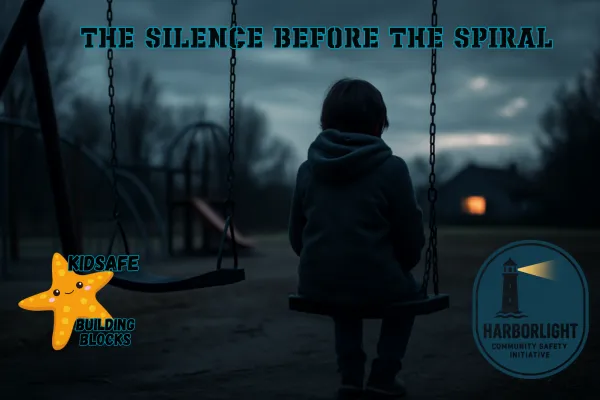
The Silence Before the Spiral
The Silence Before the Spiral: When Kids Don’t Talk About Suicidal Thoughts
By: Krista Fee
We expect certain signs.
We imagine the child in distress will lash out, withdraw dramatically, cry often, write dark poetry, or maybe post something alarming online.
But what if they don’t?
What if they show up every day smiling… and say nothing?
What if the only clue was a subtle shift, a quiet look, or the absence of a question they used to ask?
We like to believe that suicidal thoughts in kids look obvious.
But far too often, the most dangerous warning sign is silence.
When the Narrative Doesn’t Fit
Most suicide prevention education focuses on teens. High schoolers in crisis. Social media red flags. The stereotypical “troubled” kid.
But what about the 9-year-old who suddenly stops asking to play?
What about the quiet overachiever who never wants to disappoint?
What about the kid who seems “fine”… until they aren’t?
We are conditioned to miss these moments.
Why?
Because they don’t look like the movies.
Because we assume “kids don’t think like that.”
Because we mistake quiet for peace.
But make no mistake—young children can and do experience suicidal thoughts. And the more trauma, instability, bullying, or internalized shame they carry… the more that silence deepens.
Why They Don’t Tell Us
Children rarely come right out and say, “I want to die.”
It’s not because they’re hiding it—it’s because they don’t have the language.
They say things like:
“I don’t want to wake up.”
“It would be better if I wasn’t here.”
“I wish I could disappear.”
“No one would care if I was gone.”
And sometimes… they say nothing at all.
Because they don’t want to be a burden.
Because they’ve seen adults explode or shut down when emotions surface.
Because they’ve learned that pain is something you carry quietly.
Because they fear punishment, misunderstanding, or more abandonment.
The Systemic Silence Around Kids in Crisis
We don't talk enough about the rising suicide rates in children under 12.
We don’t talk about the school systems that punish behavior without exploring pain.
We don’t talk about the overworked caregivers who feel guilt but don’t know what to look for.
We don’t talk about how suicide prevention has been boxed into reactive crisis protocols instead of proactive emotional fluency, safe adult relationships, and community investment.
We don’t talk about how often we dismiss children’s pain because we’re uncomfortable with our own.
And the kids?
They absorb all of it.
Questions We Need to Be Asking
When was the last time this child saw an adult handle emotions safely and openly?
Does this child have a consistent adult in their life who listens more than they talk?
Do they know they can express hard thoughts without fear of punishment or shutdown?
Have they ever been taught that it’s okay to struggle—and still be worthy of love?
And deeper still:
What’s the emotional climate of their daily life?
Is it safe for them to be human?
The Invitation to Listen Differently
This isn’t about watching kids harder.
It’s about listening better.
It’s about learning to hear what isn’t said.
To see the shifts.
To notice the absence of joy where it once lived.
It’s about building relationships that are safe before a crisis happens.
Because no child should have to scream to be seen.
One Small Step Today
Ask the child in your life—not how they did on their homework or if they cleaned their room—but:
“How’s your heart?”
“Is there anything you’ve been holding alone?”
“When you feel sad, what helps you feel better?”
Let them talk.
Let silence linger.
Let them know you can handle the hard stuff—even if they’re not ready to share it yet.
There’s Still Time to Change This
At RISEUP Phoenix Trauma and Crisis Institute we dream of a world that's KidSAFE™, we believe prevention starts long before the hotline.
It starts with trust. With presence. With language. With listening.
And with adults who are brave enough to talk about what others refuse to.
If we want our kids to reach out… we have to go first.
